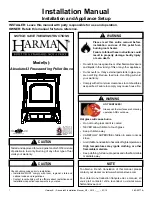
Osburn 1600 Installation and Operation Manual
12 ______________________________________________________________________________
•
FINE PAPER, COLORED PAPER OR CARDBOARD,
•
SALT WATER DRIFTWOOD
•
MANUFACTURED LOGS CONTAINING WAX OR CHEMICAL ADDITIVES
•
RAILROAD TIES
•
LIQUIDS SUCH AS KEROSCENE OR DIESEL FUEL TO START A FIRE
3.2
HOW TO PREPARE OR BUY GOOD FIREWOOD
3.2.1
WHAT IS GOOD FIREWOOD?
Good firewood has been cut to the correct length for the stove, split to a range of sizes and
stacked in the open until its moisture content is reduced to 15 to 20 per cent.
3.2.2
TREE SPECIES
The tree species the firewood is produced from is less important than its moisture content. The
main difference in firewood from various tree species is the density of the wood. Hardwoods are
denser than softwoods. People who live in the coldest regions of North America usually have only
spruce, birch and poplar, other low-density species to burn and yet they can heat their homes
successfully.
Homeowners with access to both hardwood and softwood fuel sometimes use both types for
different purposes. For example, softer woods make good fuel for relatively mild weather in spring
and fall because they light quickly and produce less heat Softwoods are not as dense as hardwoods
so a given volume of wood contains less energy. Using softwoods avoids overheating the house,
which can be a common problem with wood heating in moderate weather. Harder woods are best
for colder winter weather when more heat and longer burn cycles are desirable.
Note that hardwood trees like oak, maple, ash and beech are slower growing and longer lived than
softer woods like poplar and birch. That makes hardwood trees more valuable. The advice that
only hardwoods are good to burn is outdated. Old, leaky cast iron stoves wouldn’t hold a fire
overnight unless they were fed large pieces of hardwood. That is no longer true. You can
successfully heat your home by using the less desirable tree species and give the forest a break at
the same time.
3.2.3
LOG LENGTH
Logs should be cut about 1” (25 mm) shorter than the firebox so they fit in easily. Pieces that are
even slightly too long make loading the stove very difficult. The most common standard length of
firewood is 16” (400 mm).













































